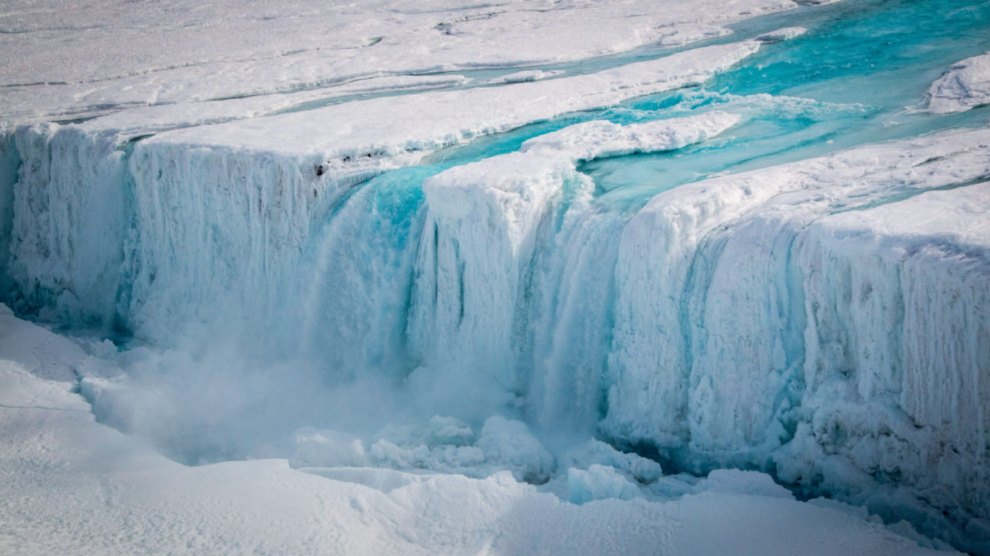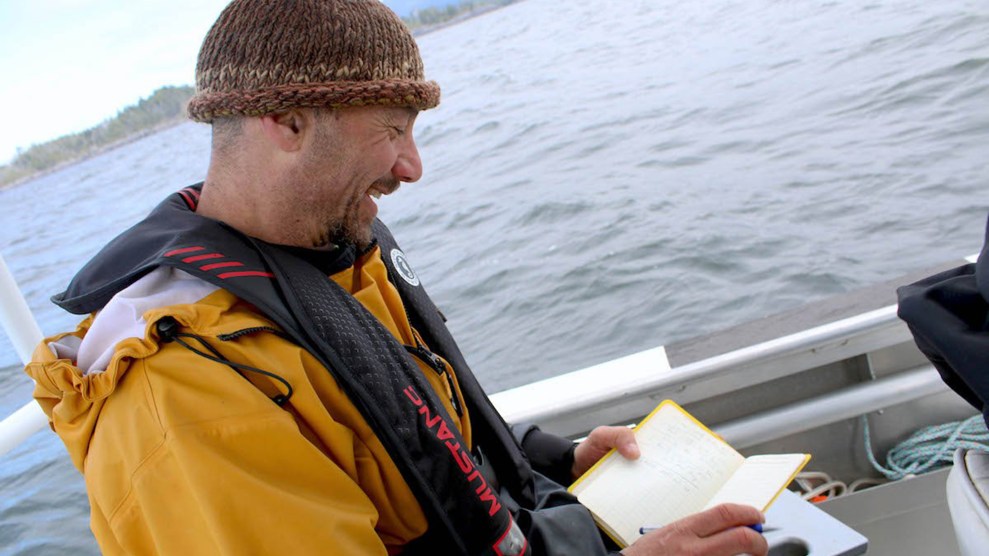
Meltwater runs off the Nansen Ice Shelf in Antarctica.C. Yakiwchuck/European Space Agency
This story was originally published by Yale E360 and is reproduced here as part of the Climate Desk collaboration.
It is being hailed as a sea change in scientific understanding of the global ocean circulation system and how it will respond as the world heats up. A doomsday scenario involving the collapse of the circulation—previously portrayed in both peer-reviewed research and the climate disaster movie The Day After Tomorrow—came a lot closer in the last month. But rather than playing out in the far North Atlantic, as previously assumed, it now seems much more likely at the opposite end of the planet.
A new analysis by Australian and American researchers, using new and more detailed modeling of the oceans, predicts that the long-feared turn-off of the circulation will likely occur in the Southern Ocean, as billions of tons of ice melt on the land mass of Antarctica. And rather than being more than a century away, as models predict for the North Atlantic, it could happen within the next three decades.
Leading ocean and climate researchers not involved in the study who were contacted for comment praised the findings. “This is a really important paper,” says Stefan Rahmstorf, an oceanographer and head of earth system analysis at the Potsdam Institute for Climate Impact Research in Germany. “I think the method and model are convincing.”
“It is the most original research I have seen for some time,” says British polar researcher Andrew Shepherd of Northumbria University, Newcastle. “I was genuinely surprised by this work, but they have convinced me. It is agenda-setting. All the attention has been on the North Atlantic; but I expect there will now be a shift in attention to the Southern Ocean.”
Meanwhile the long-standing concern about a shutdown of the ocean circulation in the North Atlantic sometime in the 21th century appears to be subsiding. A Swiss study published this month found that, contrary to past belief, the circulation did not fail at the end of the last ice age, suggesting, the researchers say, that it was more stable than previously supposed, and less likely to collapse.
Taken together the two studies bring a dramatically new perspective to the likely impact of planetary heating on ocean circulation, which is one of the great stabilizing forces of the planet’s climate system.
The ocean circulation system, often called the global conveyor, follows a regular path through the Earth’s oceans and stirs their waters from top to bottom. It starts with water plunging from the surface and disappearing to the depths, from where it travels the world and does not surface for centuries. By capturing heat and carbon dioxide from the atmosphere, and burying both deep in the ocean, it is currently moderating global warming.

The global ocean circulation system.
Ma Photo/Riccardo Pravettoni via Gridarendal
The conveyor is driven by the descent of cold, salty water to the ocean floor in just two places: in the far North Atlantic near Greenland and in the Southern Ocean around Antarctica. In both regions, the mechanism is the same. In cold polar conditions, large volumes of water freeze. The salt in the water is not incorporated into the ice. It remains in the residual liquid water, which grows ever saltier. The saltier water becomes, the denser it becomes. So the residue is heavier than surrounding water and eventually sinks to the ocean floor.
About 250 trillion tons of salty water sinks in this way around Antarctica each year, subsequently spreading north along the ocean floor into the Indian, Atlantic, and Pacific oceans. Similar volumes spread south from Greenland. The process is known as deep-water formation or ocean overturning, and it has continued largely unchanged for thousands of years.
But for how much longer? As the world warms, less ice is forming in the oceans at the ends of the Earth each year. At the same time, more ice on the nearby great ice sheets of Antarctica and Greenland is melting and releasing fresh water into the ocean.
As a result, surface water in the Southern Ocean and around Greenland is already becoming less salty, less dense, and so less able to sink. Since the 1990s, measurements taken from ships have shown that the water on the ocean floor, below 13,000 feet in depth, has warmed and freshened, with the trend strongest in the Southern Ocean.
For years, climate scientists have warned that the freshening of the North Atlantic could one day turn off the global circulation system. Such a shutdown would have wide-ranging consequences, including depriving Europe of the warming influence of the Gulf Stream in the Atlantic, which is part of global circulation, and plunging the west of the continent into a deep freeze as the rest of the world warms. Most studies conclude that this extreme scenario is a likely outcome of continued global heating, but unlikely this century.
There has been much less research into the state of Antarctic waters, however. Some oceanographers, such as Alessandro Silvano of the University of Southampton in the UK, have predicted that the melting of ice and freshening of ocean waters would reduce Antarctic bottom-water formation. The most recent assessment of the UN’s Intergovernmental Panel on Climate Change reported “medium confidence” of this occurring later this century.
But it said models were not able to quantify the impact of glacial meltwater on how fast or how far this trend might go. Rahmstorf says this failure, which arose because ice dynamics have been poorly understood and not integrated into models of climate change and ocean circulation, is “a long-standing and major shortcoming” of models presented in major IPCC reports.
Until now.
The groundbreaking modeling study published by Australian and American researchers at the end of March for the first time includes a detailed assessment of the likely impact of melting ice, revealing the importance of this past failure. It predicts a 42 percent decline in deep-water formation in the Southern Ocean by 2050. This is more than twice the 19 percent they predict for an equivalent event in the North Atlantic.
And after 2050, their model predicts that things will get even worse. Deep-water formation “looks headed towards collapse this century,” the coordinator of the study, Matthew England of the University of New South Wales, told Yale Environment 360. “And once collapsed, it would most likely stay collapsed until Antarctic melting stopped. At current projections that could be centuries away.”
“The physics at play is pretty simple,” says England. “None of the steps is particularly surprising or complex. But until our study, we did not have the circulation model … to make confident predictions.” The slowdown itself, he says, “didn’t surprise me. But the pace of change—to see a 40 percent slowdown in under three decades—was definitely a surprise.”
“This is the first time I have seen such a compelling argument for the impact of Antarctic ice melting on the Southern Ocean,” says Shepherd. “They have convinced me that current rates of melting are big enough to affect ocean circulation.”
Antarctica is by far the world’s largest repository of ice. So, Shepherd says, “we should expect the impacts of this melting to be far-reaching.” The paper’s authors agree. The slowing of ocean circulation will “profoundly alter the ocean overturning of heat, fresh water, oxygen, carbon, and nutrients, with impacts felt throughout the global ocean for centuries to come,” concludes lead author Qian Li, an oceanographer at the Massachusetts Institute of Technology.
Marine ecologists are especially concerned about the impact of a circulation shutdown on the cycling of nutrients in the ocean. Currently, nutrients fall to the ocean depths as dead marine creatures sink to the ocean floor but are brought back to the surface by the conveyor.
If there was no new deep water plunging to the ocean depths, however, there would be nothing to bring the nutrients back to the surface. Instead, the waters of the deep ocean would accumulate nutrients and become stagnant, while the supply of nutrients to sustain marine life at the surface would be drastically reduced, says one of the paper’s co-authors, Adele Morrison of the Australian National University. Marine ecosystems could collapse. This would not happen instantly. It might take centuries, but once in train could not be prevented.
A shutdown would also accelerate global warming, says Rahmstorf. “The deep-water formation sites are conduits where carbon dioxide is brought down to the ocean abyss, where it is locked away safely from the atmosphere for centuries [and] currently helps slow down global warming. However, this mechanism is set to be weakened.” The IPCC estimates that the oceans altogether capture a quarter of our CO2 emissions, much of it through deep-water formation.
Disrupting deep-water formation in the Southern Ocean would change global climate patterns in other ways that are currently hard to predict. It might shift tropical rainfall systems, says England, and perhaps make the Southern Hemisphere, as a whole, drier and the Northern Hemisphere wetter.
The Antarctic study suggests that the Southern Ocean could be about to have its own Day After Tomorrow moment. But meanwhile, for some scientists, concern about the risks of the original doomsday scenario in the far North Atlantic is abating. A Swiss study published at the start of April analyzed the climate record of marine sediments to assess the vulnerability of the North Atlantic deep-water formation to a breakdown. Lead author Frerk Pöppelmeier of the University of Bern found that the circulation “has historically been less sensitive to climate change than thought.” In particular, the circulation did not, as once believed, collapse 15,000 years ago, at the end of the last ice age. It “weakened much less than assumed,” he says.
Pöppelmeier didn’t say the findings give us an all-clear for Atlantic circulation collapse. It is far from certain how relevant his research is to the situation today. But he did conclude that “melting of Greenland’s ice in the near future will have less of a negative impact on the Atlantic circulation than previously thought.”
So have oceanographers been guilty of scare-mongering? Could those involved in the Antarctic study be exaggerating the implications of their findings?
None of the researchers contacted by Yale Environment 360 criticized the new modeling of the impact of ice-melt in the Southern Ocean itself. But some questioned the use in the model projections of an unrealistic scenario for future carbon dioxide emissions. This “business-as-usual” projection has been adopted by the IPCC as a worst-case scenario and is widely used by researchers. But it assumes continued big increases in global coal burning. Mark Maslin, an Earth scientist at University College London, says many researchers now believe this is “deeply unlikely,” as low-carbon energy sources become ever cheaper and governments and corporations remain under pressure to deliver net-zero emissions by mid-century. One study published this month predicted that carbon dioxide from burning fossil fuels to generate electricity may have peaked in 2022 and be set for a long-term decline as renewables take over.
But Rahmstorf says such optimism is ill-founded. Even if future emissions don’t rise as much as predicted, it is “irrelevant” to the near-term fate of the ocean conveyor, he says. The extent of deep-water formation in the next few decades has already been largely determined by past emissions and won’t be impacted quickly by any recent changes. “Which scenario we follow will only start to make a big difference beyond the 2040s,” he says. By then, the 40-percent weakening of bottom-water formation may be all but baked in.
















